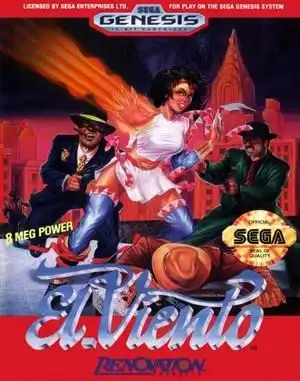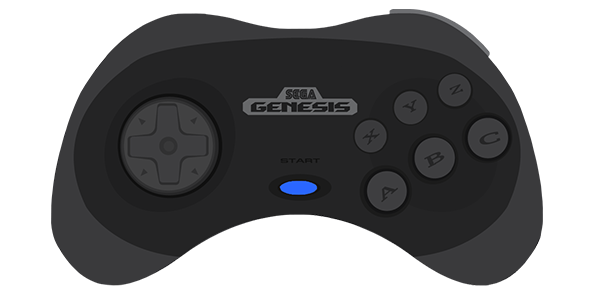El Viento on Sega Genesis: A Wild 1920s Action Ride
Remember the thrill of discovering those slightly obscure gems on the Sega Genesis? Beyond the Sonic boom and the fighting game frenzy, the Genesis library was packed with unique titles that pushed boundaries, for better or worse. One such game, a true cult classic with a blend of speed, style, and sheer strangeness, is El Viento Sega Genesis.
Released in 1991, El Viento wasn't just another run-and-gun. It threw players headfirst into a bizarre version of 1920s New York City, mixing flappers and gangsters with ancient gods and powerful magic. Developed by Wolf Team and published by Renovation Products, it stood out with its unique premise and breakneck pace.
What is El Viento?
At its core, El Viento is a fast-paced action platformer. You play as Annet Myer, a sorceress descendant of the ancient god Hastur. Unfortunately for Annet, a crazy cult leader named Henry wants to resurrect Hastur, and he needs a descendant to do it. Aided by none other than a fictionalized Al Capone (or Vicente DeMarcoto, depending on the version), Henry plans to sacrifice Annet's ancestor, Restiana. It's up to Annet to stop them, armed with infinite homing boomerangs and a growing arsenal of elemental magic.
The setting is arguably one of the game's most memorable aspects. Picture vintage cars, art deco buildings, and fedora-wearing goons... suddenly interrupted by giant monsters, floating eyes, and supernatural dimensions. It's got a distinct Indiana Jones-meets-Lovecraft vibe that few other games dared to touch, especially on the Genesis.
Annet Myer: The Sorceress with a Boomerang
Annet isn't your typical action hero. She's incredibly agile, capable of running, jumping, climbing, and even performing a unique crouching dash that lets her slide under obstacles and across gaps. Her primary weapon is an unlimited supply of homing boomerangs that automatically target enemies and can hit them on the way out and the way back.
But the real fun comes from her magic. As you progress, Annet learns various spells – from simple fireballs and ground-traveling water currents to powerful wind cutters and screen-clearing explosions. These spells consume a magic bar that quickly refills, adding a strategic layer to the constant action. Mastering the boomerang's homing ability combined with timely spell usage is key to survival.
A Wild Ride Through 1920s New York (and Beyond)
El Viento's level design is incredibly varied. You'll fight across rooftops, through sewers, inside mob hideouts, atop trains, and into increasingly bizarre, supernatural locations. This constant change of scenery keeps the game feeling fresh, even as the difficulty ramps up. Each stage culminates in a boss fight, testing your boomerang skills and magic reserves.
The game also ties into a loose trilogy from Wolf Team, preceding the somewhat infamous Earnest Evans and followed by Anetto Futatabi. While Earnest Evans is often cited for its... unique animation style and less-than-stellar gameplay, El Viento is widely considered the highlight of this connected universe, offering a far more polished and enjoyable experience despite minimal direct story links.
The Good, The Bad, and The Boomerang
El Viento has undeniable strengths. Its speed and responsiveness are fantastic for an early Genesis title. The unique setting and blend of themes are refreshing. Annet's varied abilities, especially the homing boomerang and magic, make combat engaging. The level variety is a major plus.
However, nostalgia can't completely smooth over its rough edges. The game suffers from inconsistent difficulty spikes that can feel unfair. Boss battles, while visually interesting, can sometimes feel unbalanced or drag on. And the final level is notorious among players for its relentless, often infinitely-spawning enemies, threatening to sour the experience right at the finish line. It's a game that demands patience and sometimes feels like it's actively trying to annoy you.
Is It Worth Playing Today?
Absolutely, especially if you're a fan of classic 16-bit action games and appreciate unique concepts. El Viento Sega Genesis is a fascinating snapshot of a developer trying something different on the hardware. Its flaws are apparent, but the sheer energy, distinctive style, and satisfying core gameplay loop make it a memorable title.
Finding a physical cartridge might require some searching, but like many retro games, emulation offers a readily available way to experience El Viento on modern PCs. Just be prepared for a challenge, particularly as you near the end!
Frequently Asked Questions
-
What type of game is El Viento? El Viento is a fast-paced action platformer with elements of run-and-gun gameplay and magic use.
-
Who developed El Viento? It was developed by Wolf Team and published by Renovation Products for the Sega Genesis/Mega Drive.
-
Is El Viento related to Earnest Evans? Yes, El Viento is considered the first game in a loose trilogy by Wolf Team, followed by Earnest Evans and Anetto Futatabi, though the story connections are minimal.
-
Is El Viento a difficult game? Yes, El Viento is known for having inconsistent difficulty, with significant spikes and challenging boss fights, particularly towards the end.
Final Thoughts
El Viento on the Sega Genesis is a game that sticks with you. It's weird, it's fast, and it's undeniably flawed, but its unique charm and satisfying core mechanics make it a standout title from the 16-bit era. If you're looking for a retro action game that's off the beaten path and don't mind a steep challenge, give Annet Myer's adventure a try. You might just find yourself captivated by its blend of 1920s cool and supernatural chaos.


